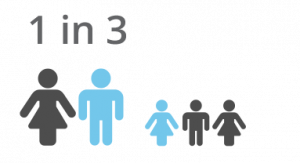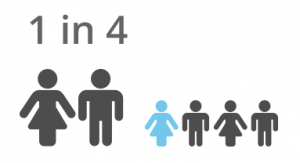WHAT IS NEARSIGHTEDNESS?
Nearsightedness, also called myopia, typically happens because the eyeballs are too long; this causes blurry distance vision. It usually starts around 8-12 years old and continues to get progressively worse until the child stops growing. The younger a child is when they first become nearsighted, the worse their prescription is likely to become. Most children who become nearsighted at a young age are often totally reliant on glasses to see by the time they have stopped growing.
Being reliant on glasses to see well leads to greater challenges in many aspects of everyday life – especially when growing up. Later in life, nearsightedness can lead to eye health and vision issues; the more nearsighted you are, the greater these risks become. That is why it’s really important to look at ways to slow down the speed at which nearsightedness progresses.

WHAT CAUSES MYOPIA?
There are two main factors which can mean your child is more at risk of developing myopia:
GENETICS
The risk of myopia in children increases when parents are myopic. The risk is nearly:

When both parents are myopic

When one parent is myopic

When neither parent is myopic
LIFESTYLE
Modern lifestyles may influence the development of myopia:

Low levels of outdoor activity

Prolonged near tasks such as reading and gaming on portable devices

Poor lighting levels
The challenge with myopia is that as the eye continues to grow, the retinal tissue has to stretch. Worsening myopia can lead to eye health and vision issues later in life.
IS THERE ANYTHING I CAN DO?
Regular eye examinations are essential for children to make sure that they are seeing as well as possible, and we can discuss strategies to reduce the risk of becoming nearsighted.
If your child is already nearsighted, you may have already experienced the need to change the prescription regularly leading to stronger glasses. Updating the glasses prescription helps with vision but does nothing to slow the speed at which the prescription changes as the eyeball continues to grow. Our clinic offers several therapy modalities to slow down myopia and the rate that the eyeball grows.
HOW CAN FAIRLAWN EYE CARE HELP?
At Fairlawn Eye Care we have diagnostic instrumentation to measure baseline axial length (length of the eyeball) and monitor change over time. This is the most effective way to monitor the progression of myopia and effectiveness of treatment.
Book an appointment with Fairlawn Eye Care to schedule an eye examination and/or assess treatment options for your child today.
MYOPIA CONTROL THERAPY: MISIGHT®, ORTHOKERATOLOGY, AND ATROPINE
MiSight® 1 day contact lenses have been specifically designed to help slow down the speed at which nearsightedness develops. They look and feel like ordinary one day soft contact lenses, but they have a very different optical design called ActivControlTM Technology. Clinical studies with MiSight® 1 day show that the speed of nearsightedness progression is slowed down by more than half compared to ordinary vision correction (Up to 59%). This means they may be less reliant on glasses, but most importantly, the risk of future eye health problems is reduced.
Orthokeratology lenses or Ortho-k Lenses are special rigid gas-permeable lenses worn during sleep to help reduce or prevent the progression of nearsightedness. They are akin to retainers for your teeth; the lenses shape the cornea (the front part of the eye) during sleep. Once the lenses are removed in the morning patients can enjoy clear glasses-free vision throughout the day. On average, ortho-k lenses reduce the progression of nearsightedness by 50-60% . Thus, orthokeratology is a great option for many patients who enjoy an active lifestyle. MOONLENS is a highly customizable ortho-k lens, constructed based on each patient’s age, prescription, eye shape, and visual needs.
If contact lenses are not a suitable option, clinical treatment with atropine eye drops can be administered. The eye drops are taken once a day before bed to control the rate of myopia progression by up to 46%. A small proportion of patients experience ocular side effects with atropine resulting in blurred near vision and light sensitivity. The doctor will determine the suitable concentration of eye drops to minimize ocular side effects.

